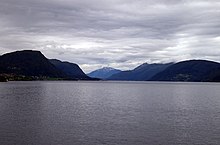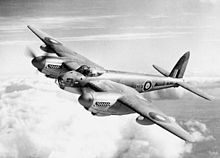Sverre Petterssen
Sverre Petterssen (born February 19, 1898 at Eidsfjord , † December 31, 1974 in London ) was a Norwegian meteorologist. He did pioneering work in the exploration of the upper air layers, discovered the jet stream and a new type of storm development . His book Weather Analysis and Forecasting was the standard textbook in English-language meteorology for two decades. During the Second World War , Petterssen was involved in the weather forecast for June 5 and 6, 1944 in the English Channel , on which the invasion of Allied troops in Normandy depended. After the war he was in charge of coordinating the global expansion of weather services.
Youth and Studies
Sverre Petterssen grew up on a farm by the Eidsfjord; the father initially worked as a fisherman, later as a sales representative. After moving several times, the family settled in Trondheim , where he left school in 1913 to work in the telegraph office. In 1915 he registered for training as a non-commissioned officer because he attended a grammar school. However, a well-meaning officer made it clear to him that he was unsuitable for a military career. In order not to have to attend war school, he signed up as an instructor for another six months.
Norway was famous among meteorologists in the early 20th century for the Bergen School of Meteorology founded by Vilhelm Bjerknes . It is thanks to her that the knowledge that wind and temperature are not continuously distributed in a low-pressure area, but rather show a discontinuity, later called the " front ". From this insight, a mechanism can be derived how storms arise. Bjerknes had meanwhile moved to the University of Oslo , where Petterssen, who first started studying geography there in 1923, was trained as a meteorologist in the tradition of the Bergen School.
As a weather observer for the Norwegian Meteorological Service
From 1925 to 1928 Petterssen worked at the Geophysical Institute in Tromsø , which also included service in remote weather stations. On such occasions he made the weather forecast in 1926 for the polar flight of the " Norge " under Roald Amundsen and Lincoln Ellsworth , and in 1928 for the failed flight of the " Italia "; Umberto Nobile hadn't followed his weather warning.
From 1928 to 1939 he worked in Bergen on methods for calculating the movement and development of storms. From 1931 he headed the regional weather service in Bergen; In 1933 he completed his doctoral thesis. A first trip to the United States followed in 1935, where he lectured for the US Navy and at Caltech .
Appointment to the USA
In 1939 Petterssen was appointed to the chair of meteorology at the Massachusetts Institute of Technology (MIT). During this time he wrote the classic textbook Weather Analysis and Forecasting (1940) as well as the Introduction to Meteorology (1941), which was freed from mathematics, for non-academically trained weather observers. When the World War broke out, around 2,700 meteorologists from the German Air Force faced only 30 meteorologists from the US Air Force, so that an emergency program for the mass training of meteorologists was started at MIT. Petterssen also introduced special courses in marine meteorology, which had gained in importance for the foreseeable war in the Atlantic.
In World War II
Sverre Petterssen describes himself as “a pacifist scientist in a technologically shaped culture in which humanism had become little more than an ornament”, but has never shown any discernible inhibitions about working for the military. Contributing to this was that his two underage daughters, Eileen and Liv, were stuck in German-occupied Norway (Liv died two weeks before Norway was liberated). In 1941, as a Norwegian citizen, Petterssen was "loaned" to the British Meteorological Office by the Norwegian government in exile .
The bombing of Germany
With the bombing of industrial centers in Germany from 1942 onwards, predicting the winds in the upper layers of the air had become an urgent problem. Petterssen became head of a working group at the British Meteorological Office in Dunstable , which explored the upper air layers ( Upper Air Branch ). To this end, he put together a team of British and Norwegian meteorologists who were flown in from Stockholm via a secret airlift. The working group investigated the formation of ground fog on British airfields, which often had a disruptive effect on the return of the bomber formations in the early morning hours.
Above all, however, it was about the wind conditions during night flights, where the drift over the ground could only be determined with difficulty. On the major bomber missions, target markers ( path finders ) set off light signals, then a first wave of bombers and finally the main bomber unit arrived. These flight movements had to be coordinated with one another with an accuracy of a few minutes at different flight altitudes, for which the wind strengths and directions in the entire airspace up to 35,000 feet had to be predicted as precisely as possible. Weather data from German weather stations were of course not available. Statistical evaluations showed that the losses increased with the errors in the wind forecasts. If the forecast was completely wrong, planes could run out of fuel before their return.
The discovery of the jet stream
When analyzing the troposphere between 25,000 and 30,000 feet, Petterssen discovered an extremely strong air current that meandered from the rocky mountains in the USA to the Soviet Union and presumably spanned the entire world. Its existence was postulated as early as 1933, but had not been proven until 1942. For reasons of secrecy, Petterssen was only able to publish his discovery after the war. The current was later called jet stream and to this day saves aircraft a lot of fuel when used skilfully.
Special missions
How much Sverre Petterssen's skills were valued can also be seen from the fact that he was used several times by the British and US-Americans for military weather forecasts that were particularly important. At the end of April 1942, for example, he predicted the weather for an attack on the Tirpitz , which was hiding in a Norwegian fjord and threatened shipping lanes to the Soviet Union. On two consecutive days, when the Tirpitz was shrouded in fog, he was able to prevent a premature attack, and it was not the weather that prevented the attack that finally took place.
For the landing of US troops near Anzio in Italy on January 22, 1944 ( Operation Shingle ), Petterssen even ventured a four-day weather forecast on January 20. His prognosis that the weather would continue to be favorable actually came true. It was noteworthy mainly because a storm had been announced by a working group in Washington under Irving P. Krick (originally Caltech ).
Of paramount importance, however, was the weather forecast for June 5 and 6, 1944 in the English Channel (detailed in this main article), because the invasion of Allied troops in Normandy depended on it. For this purpose, a complicated structure was formed from three allied weather services; Petterssen returned to his work group in Dunstable at the end of January 1944. Thanks to his experience with the upper layers of the air, he - together with his British colleague CKM Douglas - was able to consistently deliver the best weather forecasts. The two managed to prevent a landing on June 5th - in the middle of a storm. A short period of good weather the following day was also correctly predicted, so that the largest landing operation of all time could begin.
After the war
After the war, Petterssen initially headed the Norwegian weather service. At the international level, in 1946 he pushed through the project of stationing 13 ships spread across the North Atlantic to observe the weather for the commercial aviation that was now beginning. In 1948 he became scientific director of the US Air Force's weather service. During this time he also headed an ad hoc committee to investigate the suitability of artificially generated rain as a weapon. The investigations are said to have ended without a clear result.
In 1952 he was appointed professor at the University of Chicago . Almost immediately afterwards, he was lucky enough to see a new type of storm . The November 25, 1952 storm over the Midwest was not predicted because it contradicted the rules of the Bergen School. According to these rules, hot and cold air masses must collide for a storm and, under certain conditions, discharge in a storm until the temperature is balanced. In this case, however, the temperature differences had been small initially and had increased during the storm. Petterssen was able to show that these Chicago-type storms, as they were now called, even formed the rule in the area between the rocky mountains and the east coast. However, he never found a theoretical explanation for it. He also revised his textbooks, which have now become classics, and which have now been translated into languages such as Hindustani , Japanese, Polish and Russian.
Petterssen was President of the American Meteorological Society , advised the US President on science issues and the National Academy of Sciences on expanding atmospheric sciences. With his retirement he went to England in 1963. After the 1973 Watergate Affair , he renounced US citizenship and remained stateless until his death the following year.
Honors
- Commander of the British Empire (1947)
- Buys Ballot Medal of the Royal Netherlands Academy of Sciences (1948)
- IMO Prize of the World Meteorological Organization (1965)
Fonts (selection)
- Sverre Petterssen: Weathering the Storm. Sverre Petterssen, the D-Day Forecast, and the Rise of Modern Meteorology . American Meteorological Society, Boston 2001. ISBN 1-878220-33-0 . (Life memories)
- Sverre Petterssen: Weather Analysis and Forecasting: A textbook on synoptic meteorology . McGraw-Hill, New York 1941. (Republished in two volumes 1956)
- Sverre Petterssen: Introduction to Meteorology . McGraw-Hill, New York 1941. (Republished 1958)
- Studies in Weather Analysis and Forecasting . Edited by Sverre Petterssen. University of Chicago, Chicago 1954, 1957, 1960 and 1963 (four volumes).
Web links
| personal data | |
|---|---|
| SURNAME | Petterssen, Sverre |
| BRIEF DESCRIPTION | Norwegian meteorologist |
| DATE OF BIRTH | February 19, 1898 |
| PLACE OF BIRTH | at Eidsfjorden , Norway |
| DATE OF DEATH | December 31, 1974 |
| Place of death | London |




